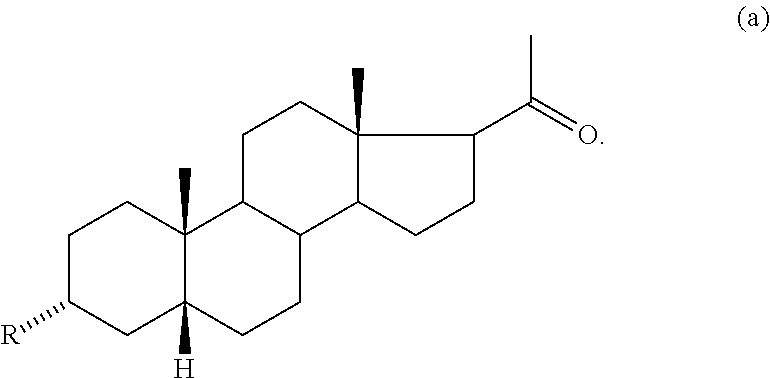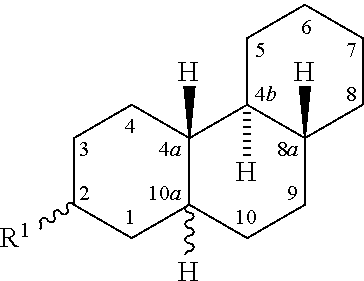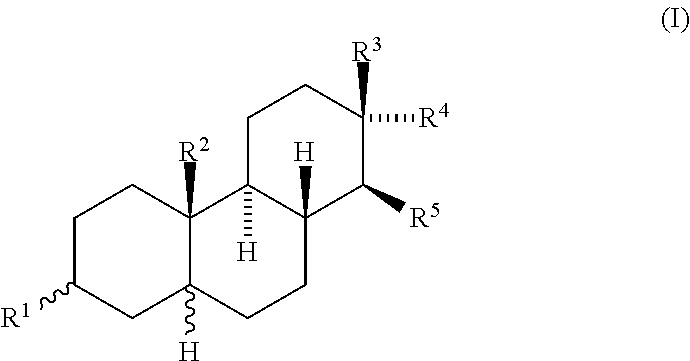Amphiphilic compounds with neuroprotective properties
a technology of amphiphilic compounds and neuroprotective properties, applied in the field of pharmaceutical chemistry, can solve the problems of small neuroprotective potential, neurotoxicity cascade, and serious side effects
- Summary
- Abstract
- Description
- Claims
- Application Information
AI Technical Summary
Benefits of technology
Problems solved by technology
Method used
Image
Examples
example 1
(S)-6-(Ethylendioxy)-8a-methyl-3,4,6,7,8,8a-bexahydronaphtalen-1(2H)-one (2)
[0146]Diketone 1 (7.36 g, 41.3 mmol), triethyl orthoformiate (7.58 ml, 45.6 mmol), and ethylene glycol (12.7 ml, 228 mmol) were dissolved in DCM (50 ml) and cooled to −10° C. Then, trifluoromethanesulfonate (150 ml, 830 μmol) was added and the mixture was stirred at −10° C. for 1 h. Then, triethylamine (200 ml, 1.43 mmol) was added and the reaction mixture was poured into saturated aqueous sodium bicarbonate solution. The product was extracted into dichloromethane (3×50 ml). The combined organic extracts were dried over anhydrous magnesium sulfate and the solvents evaporated under reduced pressure. Residue was purified by column chromatography on silica gel (150 g, 20% ethyl acetate in petroleum ether) affording 7.88 g (86%) of monoketal 2: mp 48-51° C., [α]D20+97.7 (c 0.27, CHCl3). 1H NMR (400 MHz, CDCl3): δ 1.32 (s, 3H, H-19), 1.65 (qt, J1=13.3, J2=4.6, 1H, H-7b), 1.69-1.77 (m, 1H, H-1b), 1.77-1.89 (m, 2H,...
example 2
(S)-7-(Ethylenedioxy)-4b-methyl-1,2,4b,5,6,7,9,10-oetabydrophenanthren-3(4H)-one (3a) and (4bS,10aS)-7-(ethylenedioxy)-4b-methyl-1,2,4b,5,6,7,10,10a-octahydrophenanthren-3(9H)-one (3b)
[0147]Sodium hydride (9.39 g, 235 mmol, 60% suspension in oil, washed with tetrahydrofuran, 3×25 ml) in tetrahydrofuran (10 ml) was added to a cooled (0° C.) solution of ketone 2 (20.87 g, 93.89 mmol) in dry ethyl formate (250 ml). Then, methanol (3.80 ml, 93.9 mmol) was added dropwise over 15 min at 0° C. The reaction mixture got thickened within a few minutes and after 30 minutes was warmed to room temperature. After an additional 30 min, it was quenched with saturated ammonium chloride solution (400 ml) and the product was extracted with ethyl acetate (3×100 ml). The combined organic extracts were dried over anhydrous sodium sulfate, the solvent evaporated under reduced pressure to afford a quantitative amount of the crystalline formyl derivative: 1H NMR (400 MHz, CDCl3): δ 1.37 (3H, s, CH3-19), 1.8...
example 3
(4bS,10aS)-7-(Ethylendioxy)-4b-methyl-1,2,4,4a,4b,5,6,7,10,10a-decahydrophenanthren-3(9H)-one (4)
[0150]To the dried (lithium wire and a catalytic amount of ferric chloride) freshly distilled liquid ammonia in a three-necked flask, cooled to −78° C. under a condenser with solid carbon dioxide was under a nitrogen atmosphere, a solution of enone 3a (9.074 g, 33.07 mmol) in tetrahydrofuran (90 ml) was added followed by ethanol (4.96 ml, 84.9 mmol). Then, under intensive stirring, lithium metal (2.66 g, 383 mmol) cut in small pieces were added portionwise. When a persistent blue coloration showed complete reduction, excess ammonia was gently evaporated. The residue was poured into saturated aqueous sodium bicarbonate (300 ml) and the product was extracted into ethyl acetate (3×100 ml). The combined organic extracts were washed with saturated aqueous sodium chloride solution, dried over anhydrous magnesium sulfate and evaporated under reduced pressure. The residue was purified by column ...
PUM
| Property | Measurement | Unit |
|---|---|---|
| pressure | aaaaa | aaaaa |
| temperature | aaaaa | aaaaa |
| temperature | aaaaa | aaaaa |
Abstract
Description
Claims
Application Information
 Login to View More
Login to View More - R&D
- Intellectual Property
- Life Sciences
- Materials
- Tech Scout
- Unparalleled Data Quality
- Higher Quality Content
- 60% Fewer Hallucinations
Browse by: Latest US Patents, China's latest patents, Technical Efficacy Thesaurus, Application Domain, Technology Topic, Popular Technical Reports.
© 2025 PatSnap. All rights reserved.Legal|Privacy policy|Modern Slavery Act Transparency Statement|Sitemap|About US| Contact US: help@patsnap.com



